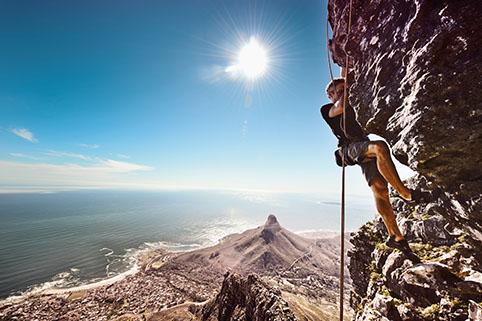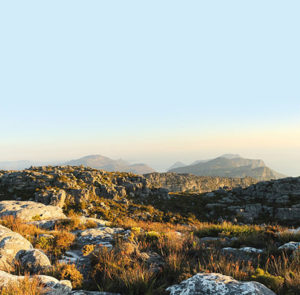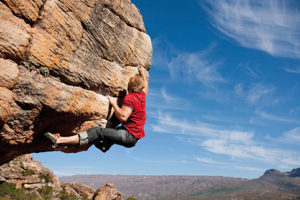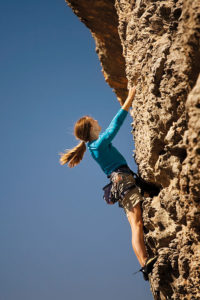It’s hardly a new sport, but the past decade has witnessed unprecedented growth. Megan Banner harnesses up to see how rock climbing can offer a new perspective on the country’s stunning landscapes
I have spent the past hour on the side of a vertical cliff, attached to nothing but a rope. Now I finally pull myself over the upper ledge, almost 90m off the ground. Wearing a sweaty, dirty face; aching muscles; and a big smile, I turn away from the amazing view to be greeted by … a 10-year-old girl in a sundress. Clearly somewhat bewildered, and with the rest of her picnic party behind her, she looks up and asks me, ‘Why didn’t you just take the path?’
It’s a fair question. I have been rock climbing for eight years now, and freely admit it’s hard work. It involves special equipment and know-how and should reveal plenty of muscles you didn’t even know existed. But I can also confidently say that it’s just tons of fun and I have watched countless people get hooked.
Climbing requires you to figure out how to move your body in convoluted ways to accomplish difficult moves while ignoring the fact that the ground may be very, very far away. Doing it all right is truly exhilarating, and it comes with bonuses including that spectacular view I mentioned, a story to swap later over dinner, and the sense of accomplishment you earn – unmatched by any picnic I’ve ever joined.
But let’s rewind to figure out what exactly ‘rock climbing’ means. It comes in many flavours, but it’s useful to put the common types into two categories: bouldering and ropes.
Bouldering happens relatively close to the ground – normally on free-standing rocks up to about five metres tall – and is therefore the more fuss-free option. And when you inevitably fall, it is on to portable mattress-like things called ‘crash pads’ (also fantastic for afternoon naps). Because the effort is concentrated into such a short climb, bouldering can be quite burly and is all about linking a few difficult moves in a row.
Roped climbing, in contrast, ends at any height beyond a couple of metres. It’s more about endurance and comes with significant safety considerations. In sport climbing, my favourite type, you ascend via a route of permanent bolts, clipping your rope into each one as you pass. I love the feeling of being alone above the world, and being able to move smoothly without too much fiddling with equipment. Another style – for the real gearheads – is traditional climbing, which makes it possible to climb without bolts by securing your rope to removable metal pieces placed in natural cracks in the rock.
The best part: anyone can give it a shot. Really! I hail from the Northeast US originally, and still cannot believe what a climber’s paradise South Africa is. This country has some of the best and most diverse climbing in the world, all obligingly not covered in snow four months of the year. Waterval-Boven in Mpumalanga has more than 600 routes. The Cederberg, a couple of hours’ drive north of Cape Town, is a world-famous bouldering area. The Eastern Cape is peppered with dozens of smaller crags, ideal for weekend getaways. And Cape Town and Durban both offer stellar, super-accessible urban climbing.
I currently live in Cape Town, which, perhaps rather predictably, is quite the climbing hub. It offers every type you can think of within city limits – even indoor at CityROCK gym. Climbing indoors is great for getting started in a safe, fun environment; and a place to meet more advanced climbers, who gather to practise techniques and plan their next epic adventure.
With no shortage of opportunities to try it out, it’s easy to understand why the South African climbing scene is growing so quickly. People flock here from all over the world for a taste, and most climbers I know take beginners out with them on a regular basis. Easy options for spending a few hours at the crag abound in many areas, but the truly amazing thing about this country is all the wide, open space.
The sheer volume of rock can absorb the many thousands who’ve fallen in love with the sport, and new cliffs to climb are still being discovered. A big part of the adventure is the strict code of ethics by which climbers abide – to control access and ensure special areas remain beautiful and unspoilt for generations to come.
So, besides an excuse to collect yet another closetful of gear, climbing is a chance to explore pristine and downright gorgeous wilderness, all while pushing your physical limits, learning about yourself and forging bonds with a great community.
I don’t know about you, but I’ll choose all that over ‘just take the path’ any day.
GOOD TO KNOW
Where to go
Most cities have indoor gyms – pop in for a visit! You’ll receive instruction and don’t need your own gear. The Mountain Club of South Africa is another great resource, with 14 chapters nationwide. http://cen.mcsa.org.za
What you’ll need
For indoors, just comfy gym clothes and some water. Venturing outside requires – at a minimum – a harness, rope, special shoes, belay device, and metal safety pieces. Getting your own gear is not recommended at first. However, once you are ready to commit, many climbing gyms have their own shops or you can order online.
www.mountainmailorder.co.za.
Photography istockphoto
(This article was first published in the winter 2015 issue of AA traveller magazine)







